The insurance industry, particularly in the competitive North American markets of the US and Canada, is facing an unprecedented mandate for speed, accuracy, and customer-centricity. The era of manual, paper-driven processes is now behind us.
Leading this seismic shift is RPA in insurance claims processing—a technological imperative that not only optimizes back-office functions but also fundamentally redefines the customer experience and the insurer’s bottom line.
This blog, authored by a senior expert, serves as the definitive guide for U.S. and Canadian insurers. We explore how Robotic Process Automation (RPA) in insurance, combined with AI and ML, drives dramatic process efficiency, fortifies fraud detection, and secures a measurable competitive advantage.
Introduction: RPA is Leading the Digital Charge
The pressure on modern insurers is immense: increasing policyholder expectations for instant gratification, the rising complexity of claims (especially in property and casualty due to climate events), and relentless regulatory oversight. For organizations anchored to legacy systems, achieving scale, compliance, and customer satisfaction simultaneously seemed impossible.
Forward-thinking insurers are leveraging these technologies to execute high-volume, repetitive tasks with superhuman speed and precision. This has resulted in a 70% reduction in claims turnaround times, saving the industry an estimated $6.5 billion annually in operational costs. Claims that previously took weeks are now being resolved in hours or even minutes, directly resulting in increased customer satisfaction.
What is RPA in Insurance Claims Processing?
Robotic process automation in insurance claims processing is the strategic deployment of software robots, or “bots,” to mimic human actions when interacting with digital systems. These bots are rules-based and operate directly within the existing user interface and application layer, making them an ideal, non-invasive solution for connecting disparate legacy systems without the need for complex and costly system overhauls.
Specifically, RPA in claims management is designed to automate the data-intensive, repetitive tasks that consume the majority of a claims adjuster's time across the claims lifecycle.
Key Attributes of RPA in Claims Management:
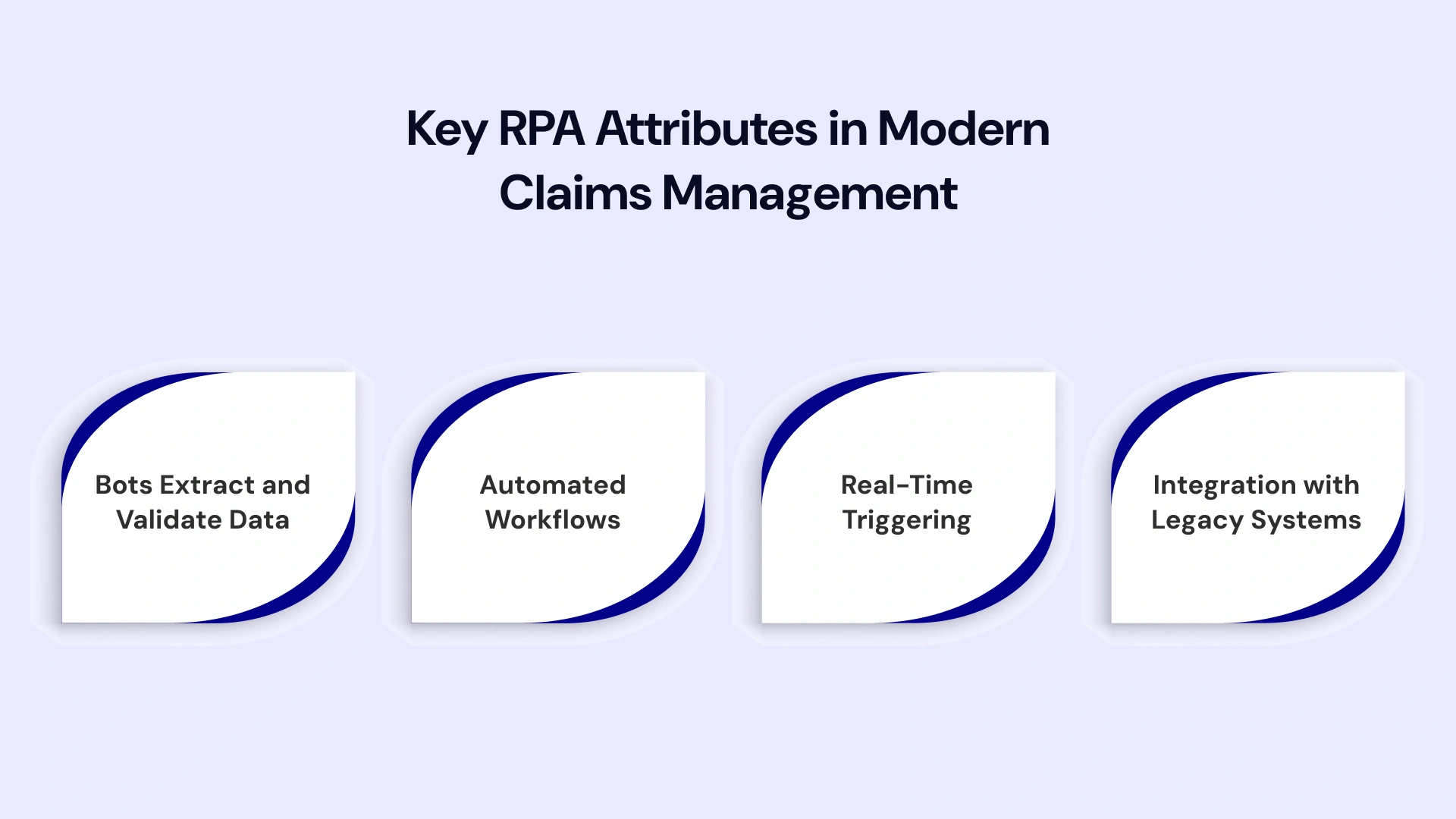
- Automated Workflows: The bots initiate, route, and assign claims based on complexity, policy type, and value, ensuring straight-through processing for simple, low-value claims.
- Real-Time Triggering: RPA bots for insurance claims automatically trigger subsequent actions, such as generating customer notifications, calculating preliminary settlement amounts, creating compliance logs, and initiating payment processing.
- Integration with Legacy Systems: One of the most critical functions of RPA solutions for insurance claims is their ability to bridge the gap between decades-old legacy platforms and modern applications, facilitating seamless data flow without requiring expensive API development.
This robust framework ensures that the implementation of insurance claims process automation software is swift, minimally disruptive, and delivers an immediate return on investment.
Why Insurers Are Investing in RPA Solutions
The business case for RPA for insurance companies extends far beyond simple cost reduction. It is a strategic investment that enables insurers to scale operations, drastically reduce risk, and pivot the focus of their human talent toward high-value, empathetic customer service.
Benefits of RPA in Insurance
The value proposition of robotic process automation in insurance can be categorized into tangible, quantitative, and qualitative benefits:
Quantitative Benefits
Quantitative Benefits | Impact on Claims Processing |
Up to 75% Faster Processing | Drastically accelerates claim settlements, translating directly to higher customer satisfaction (CSAT) scores and improved Net Promoter Scores (NPS). McKinsey research has shown RPA can reduce data processing time in insurance by 34%. |
Up to 99.5% Data Accuracy | Eliminates manual data entry errors, which are costly, and reduces the likelihood of mistaken payouts or denials, ensuring consistency across all processed claims. |
25-80% Reduction in Claim Expenses | Achieved by minimizing the administrative costs associated with manual labor, rework due to errors, and time spent on compliance reporting. |
Increased Workforce Capacity (up to 30%) | Frees human claims adjusters from mundane tasks, allowing them to focus on complex, exception-based cases and empathetic customer interaction, which drives long-term loyalty. |
Qualitative Benefits
Qualitative Benefits | Impact on Business Strategy |
Improved Compliance and Auditability | Every action a bot takes is logged, providing an instant, immutable audit trail. This is vital for meeting stringent US and Canadian regulatory standards and significantly reduces the risk of penalties. |
Enhanced Customer Experience | The speed and transparency offered by automation in insurance claims processing (e.g., real-time status updates) meet the high expectations of the modern, digital-first policyholder. |
Reduced Fraud Risk | AI-enabled RPA bots can monitor for and flag suspicious patterns in claims data instantly, a task impossible for humans to manage at scale. |
Scalability and Resilience | Bots can be quickly scaled up to handle sudden, high-volume claim surges (e.g., following a major weather event in Canada or the US), ensuring business continuity without increasing headcount. |
RPA Use Cases in Insurance: Claims Processing Automation Tools in Action
The adoption of RPA in insurance claims processing is not limited to a single step; instead, it provides end-to-end transformation across the entire claims lifecycle. These are the top use cases leveraging claims processing automation tools:
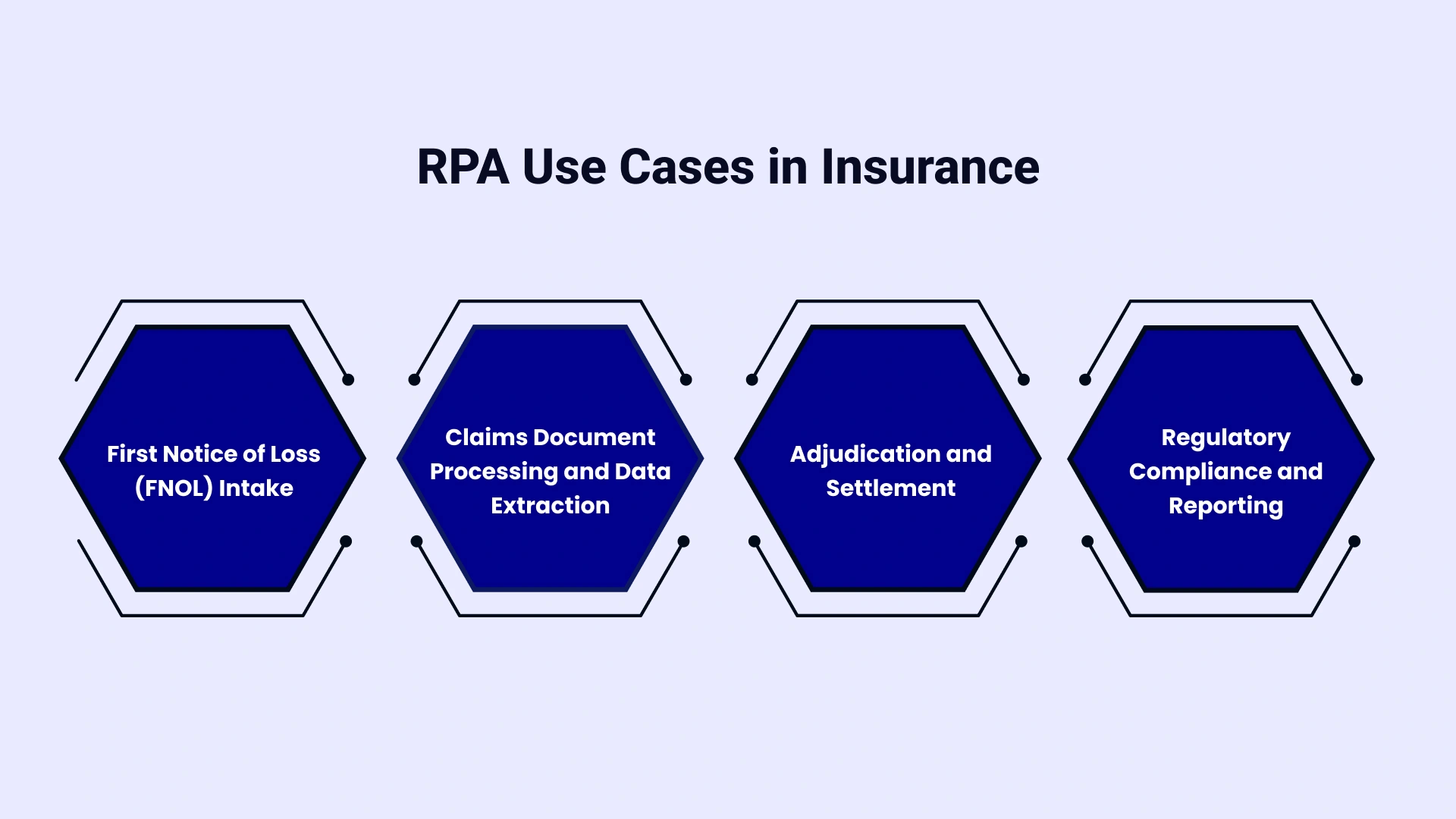
1. First Notice of Loss (FNOL) Intake
- Process: The FNOL is the initial reporting of a claim. It often comes via email, web forms, or even fax.
- RPA Action: Bots automatically monitor multiple intake channels, extract key identifiers (policy number, claimant name, date, and description of loss), cross-reference data with the policy administration system, and auto-populate the FNOL form in the core claims system. The bot then initiates the claims workflow.
- Benefit: Dramatically reduces the time-to-claim initiation, which is a key metric for customer satisfaction.
2. Claims Document Processing and Data Extraction
- Process: Claims require handling massive volumes of unstructured data from medical bills, repair estimates, appraisal reports, and police reports.
- RPA Action: Advanced insurance claims process automation software utilizes a combination of RPA and AI (known as Intelligent Document Processing or IDP) to categorize documents, extract specific data fields (e.g., cost line items, diagnosis codes), and validate the extracted data against policy terms.
- Benefit: Enables straight-through processing by making the data immediately machine-readable, enhancing process efficiency in insurance claims.
3. Adjudication and Settlement
- Process: Evaluating a claim against policy terms and calculating the final payout.
- RPA Action: For simple, low-complexity claims (e.g., minor hail damage, simple theft), bots compare the claim data against predefined policy rules and limits. If all criteria are met, the bot auto-adjudicates and triggers the payment system. Complex cases are automatically flagged and routed to a human adjuster.
- Benefit: Frees up human adjusters to concentrate on high-value, complex, or escalated claims.
4. Regulatory Compliance and Reporting
- Process: Generating logs, reports, and ensuring every step adheres to regional regulatory bodies (e.g., state or provincial laws).
- RPA Action: Bots maintain an exhaustive, tamper-proof log of every transaction. They also automate the compilation of compliance reports (such as financial or audit reports), pulling required data from disparate sources into the mandated format.
- Benefit: Guarantees compliance and significantly reduces the risk of expensive regulatory penalties.
How AI is Transforming Claims Processing in Insurance
While RPA automates rule-based tasks, intelligent automation in insurance—the combination of AI and RPA —is crucial for automating knowledge-based tasks, incorporating decision-making, learning, and prediction into the workflow. The synergy of AI and RPA in insurance claims creates the ultimate competitive advantage.
Key AI Augmentations in Claims
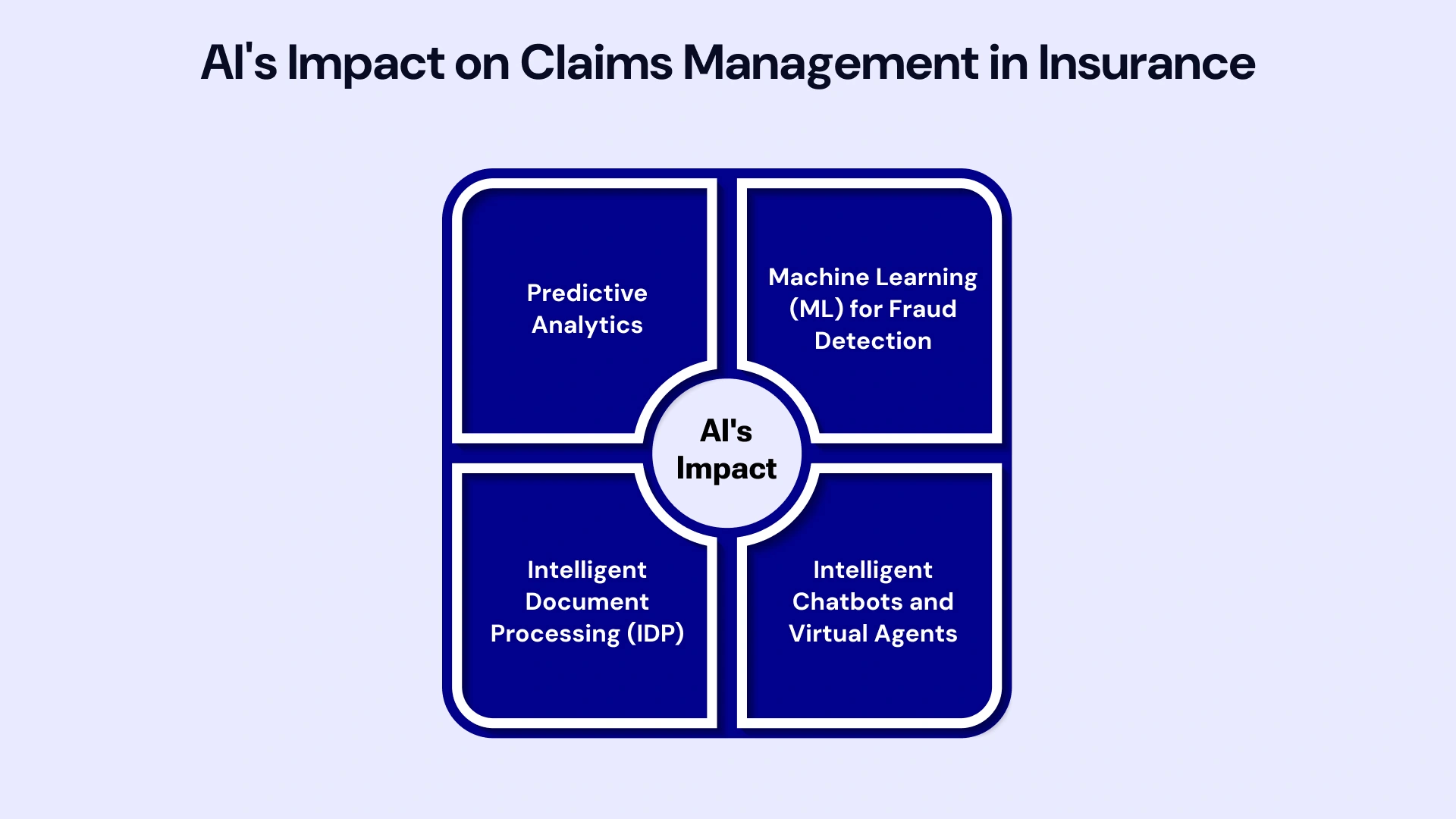
- Predictive Analytics: AI models analyze historical claims data, loss patterns, and risk factors to predict the likelihood of claim severity, duration, and even potential fraud risk. This intelligence is fed directly to the RPA bots, which then use it to route the claim appropriately.
- Machine Learning (ML) for Fraud Detection: ML algorithms continually learn from new claim submissions and historical data to identify subtle anomalies and flag suspicious claims in real-time. This proactive capability is a massive advantage over traditional, retrospective fraud detection methods.
- Intelligent Chatbots and Virtual Agents: Top AI-powered chatbots handle up to 80% of routine customer queries, such as "What is my claim status?" or "What documents do I need?", providing instant, 24/7 service, which is critical for maximizing customer experience and increasing marketing ROI in Insurance by reducing contact center load.
- Intelligent Document Processing (IDP): This is where AI truly transforms data extraction. IDP uses computer vision and NLP to understand the meaning and context of unstructured documents, not just the characters, ensuring highly accurate data extraction for claims data processing automation.
This fusion of technologies means that AI transformation in insurance claims is constantly evolving, moving beyond simple task automation to full-scale, end-to-end process optimization.
Step-by-Step Guide to Implementing RPA in Insurance
Implementing robotic process automation in insurance is a strategic journey that requires meticulous planning and execution. A senior expert approach follows these five critical steps to ensure a successful, high-ROI deployment.
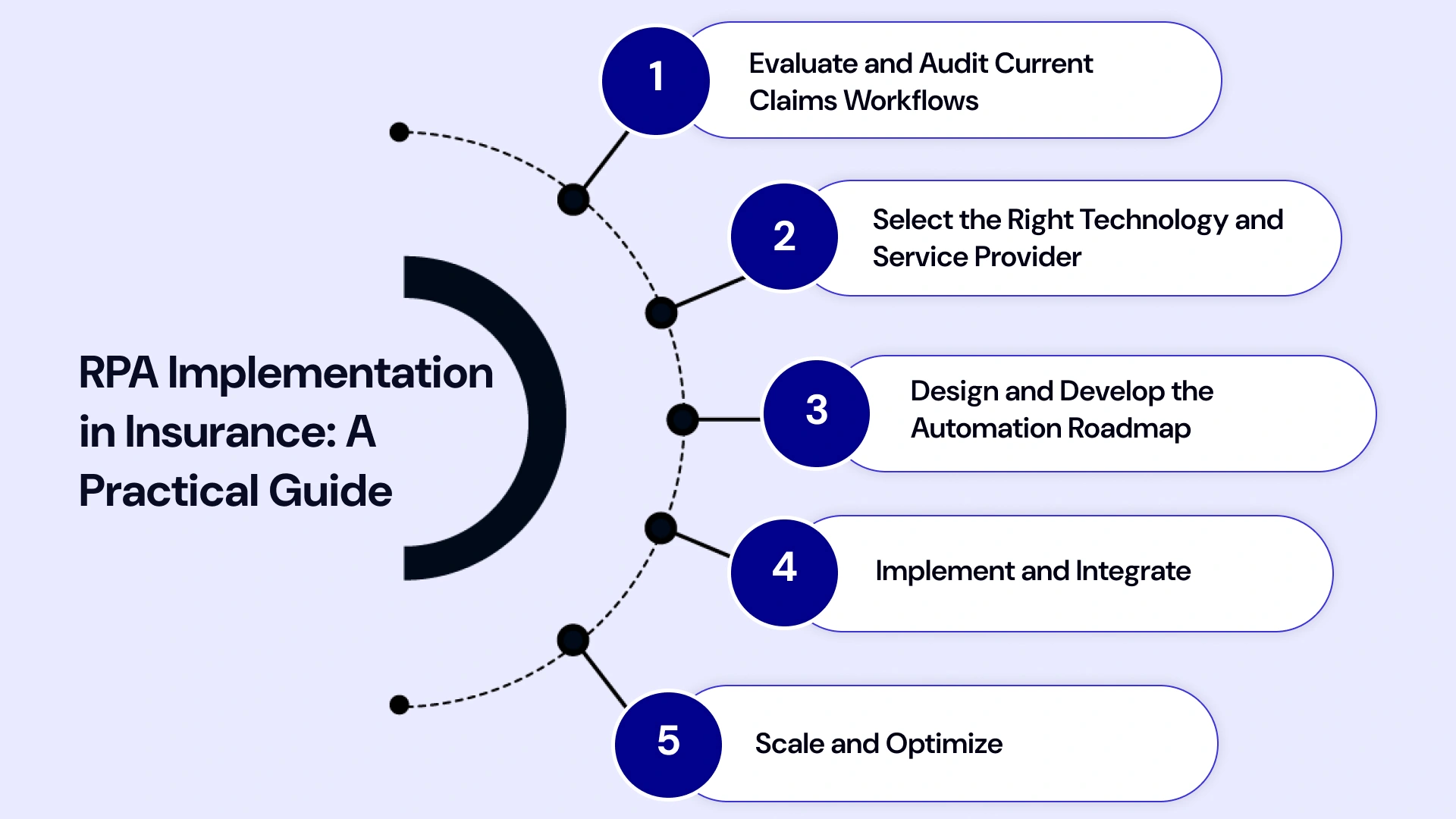
1. Evaluate and Audit Current Claims Workflows
Before implementing any RPA solutions for insurance claims, a comprehensive audit is mandatory.
- Identify Automation Candidates: Pinpoint processes that are high-volume, repetitive, rules-based, and suffer from long turnaround times or high error rates. FNOL and compliance reporting are typically "quick wins."
- Process Mapping: Document the end-to-end claim journey, identifying all systems, applications, and human touchpoints involved in the process. Assess legacy systems for integration requirements.
- Metrics Baseline: Establish Key Performance Indicators (KPIs) to accurately measure the impact of RPA in insurance claims processing, including the current average processing time, cost per claim, and error rate.
2. Select the Right Technology and Service Provider
The choice of RPA software for insurance claims and partners is crucial.
- Evaluate RPA Tools: Assess leading best RPA tools for insurance companies (e.g., UiPath, Automation Anywhere, Blue Prism) based on scalability, governance features, security, and native AI/cognitive capabilities.
- Choose an Expert Partner: Select an insurance claims automation service provider or an RPA service provider for the insurance industry that demonstrates deep expertise in the complex regulatory environment of the insurance sector and has a proven RPA case study with examples of insurance claims processing in the US and Canada. This expertise is vital for minimizing implementation risk.
3. Design and Develop the Automation Roadmap
A phased approach maximizes ROI and minimizes disruption.
- Proof of Concept (PoC): Begin with a straightforward, high-value process (e.g., data validation). This PoC validates the technology and builds internal confidence.
- Prioritize & Roadmap: Group automation candidates into phases, prioritizing quick-win processes that generate measurable cost savings fast. Develop the insurance workflow automation blueprint.
4. Implement and Integrate
This phase involves the actual deployment of the RPA bots for insurance claims.
- Development and Testing: Build and rigorously test the bots in a controlled environment to ensure their reliability and effectiveness. Deploy the new automated workflows in parallel with existing manual processes.
- Integration: Utilize the bot's capability to operate at the UI level or through low-code/API connectors to integrate seamlessly with existing core systems, ensuring no disruption to data integrity or business continuity.
5. Scale and Optimize
Successful implementation is only the beginning. The goal is to achieve enterprise-wide intelligent automation in the insurance industry.
- Monitor and Refine: Utilize analytics to monitor bot performance and identify bottlenecks continuously. Refine the bots using user feedback for ongoing process efficiency in insurance claims.
- Expand Scope: Scale the deployment to other areas, such as underwriting, renewals, and insurance back-office automation, integrating with a broader insurance policy administration automation strategy. This multi-departmental approach is key to achieving maximum value from digital transformation in the insurance industry.
Real-World Example: RPA Case Study in Insurance Claims Processing
The impact of robotic process automation in insurance is best demonstrated through real-world results. A major North American Property and Casualty (P&C) insurer, struggling with rising operational costs and slow cycle times, partnered with a top automation company for insurance to implement an RPA-first strategy for its motor claims division.
- The Challenge: The claims intake and validation process was entirely manual, involving five different legacy systems, multiple data entry points, and an average cycle time of 14 days for a simple claim. This led to a high error rate, poor customer experience, and significant adjuster burnout.
- The RPA Solution: The insurer deployed a suite of RPA bots for insurance claims to handle:
- FNOL Digitization: Bots extracted data from all digital claim intake forms and emails.
- Cross-System Validation: Bots automatically logged into three separate legacy systems to verify policy status, check policy exclusions, and validate claimant identity.
- Preliminary Decisioning: Bots compared verified data to a rule set to auto-approve simple claims below a specific financial threshold.
Tangible Business Impact:
- Cycle Time Reduction: The average claim cycle time for simple motor claims slashed from 14 days to under 5 days.
- Cost Savings: An estimated 30% drop in claim processing costs was achieved within the first 18 months.
- ROI and Accuracy: The insurer reported a 200% ROI in the first year alone, with data accuracy approaching 100%. Automated audit trails significantly bolstered compliance scores.
- Customer Experience: Customer satisfaction scores for the automated claim line rose 25%, transforming a cost center into a powerful retention tool.
This RPA case study in insurance claims processing underscores the transformational power of a well-executed automation strategy.
RPA Applications Beyond Claims Processing
While RPA in insurance claims processing is the immediate high-ROI starting point, the technology is a foundational element of enterprise-wide digital transformation in the insurance industry.
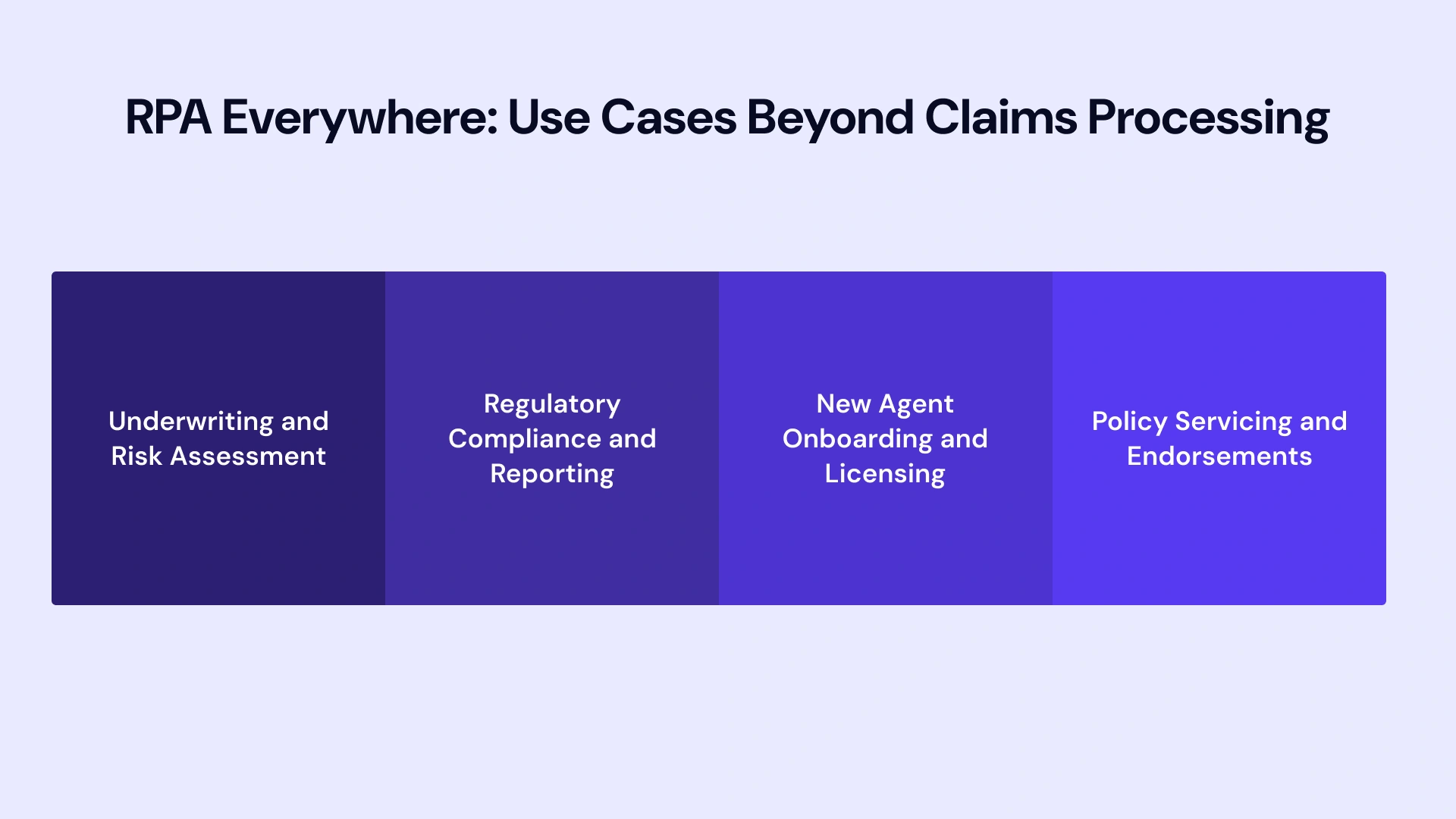
- Underwriting and Risk Assessment: Bots gather and validate applicant data from multiple internal and external systems (e.g., credit reports, property data), calculate risk scores using AI/ML models, and automatically generate initial quotes, thereby speeding up the decision-making process for underwriters.
- Regulatory Compliance and Reporting: RPA monitors evolving regulations, automatically audits policy and process data against new rules, generates complex regulatory reports (e.g., Solvency II, IFRS), and instantly flags non-compliant transactions, significantly reducing compliance risk and cost.
- New Agent Onboarding and Licensing: Automation streamlines the credential verification, background checks, license tracking, and system provisioning for new agents and brokers, ensuring compliance and drastically cutting the time-to-productivity for the sales force.
- Policy Servicing and Endorsements: Bots automate high-volume administrative tasks related to existing policies, such as processing address changes, updating beneficiaries, calculating premium adjustments for policy endorsements, and generating renewal packages.
The Future of RPA in Insurance Industry: Hyperautomation and AI
The future of RPA in the insurance sector is defined by the convergence of technologies; a concept known as Hyperautomation.
By 2028, the market for AI and RPA is expected to continue its aggressive growth, driven by the demand for hyper-personalized customer experiences and the relentless pursuit of process efficiency in insurance claims. Intelligent automation in insurance will evolve to integrate even more closely with Machine Learning (ML) and Generative AI (GenAI), moving beyond the use of structured data.
Future RPA solutions for insurance claims will:
- Handle Unstructured Data Contextually: AI will analyze the sentiment in a policyholder's email or the nuances of a repair quote, feeding that context to the bot for a more informed, automated decision.
- Dynamic Bot Creation: GenAI will assist developers in creating and deploying RPA bots for insurance claims more efficiently, thereby accelerating automation across the enterprise.
- Risk Mitigation: Advanced analytics, powered by AI, will enable real-time risk assessment at every stage, dramatically improving the accuracy and effectiveness of fraud detection.
Marketing ROI Strategies for Insurance
Digital-first consumers demand hyper-personalized, instant experiences. Automation is now the essential engine for marketing and sales, transforming how insurers acquire, service, and retain customers, directly impacting the bottom line (ROI).
Automation eliminates one-size-fits-all campaigns, replacing them with dynamic, context-aware customer journeys:
- Automated Lead Nurturing: Bots track prospect behavior (e.g., completed a quote but didn't buy) and automatically trigger personalized follow-up campaigns with relevant content, success stories, or limited-time offers, significantly boosting quote-to-conversion rates.
- Hyper-Personalized Cross-Selling: By analyzing a customer's policy and lifestyle data, AI-driven automation identifies relevant upsell/cross-sell opportunities (e.g., suggesting a home contents rider after a new homeowner's policy purchase) and instantly executes a targeted communication via the customer's preferred channel.
- Customer Retention: Automated communication sequences manage critical touchpoints, such as payment reminders and renewal notifications, ensuring timely actions are taken. Meanwhile, conversational AI chatbots handle routine 24/7 inquiries, freeing human agents to focus on complex, high-value customer interactions.
By leveraging automation to deliver the right message to the right person at the exact right time, insurers see a measurable increase in conversion rates, customer lifetime value, and overall maximize marketing ROI in Insurance.
Maximize Efficiency: VLink's Insurance Automation Solutions
Implementing a strategic, high-ROI solution like RPA in insurance claims processing requires more than just technology; it demands deep industry knowledge, proven implementation methodologies, and a partner committed to your long-term digital transformation in the insurance industry.
VLink offers specialized insurance software development services designed to transition insurers in the US and Canada from legacy constraints to intelligent automation leaders.
Our dedicated experts understand the complex regulatory landscapes of North America and specialize in seamlessly integrating RPA solutions for insurance claims with existing core systems. We don’t just deploy bots; we optimize your end-to-end insurance workflow automation to ensure maximum process efficiency in insurance claims, superior compliance, and measurable savings.
From initial process discovery and selection of the best RPA tools for insurance companies to continuous optimization and the scaling of AI and RPA integration in insurance, VLink serves as your dedicated strategic insurance claims automation service provider—partner with us to achieve accelerated time-to-value and ensure the success of your automation initiatives.
Conclusion
The choice for insurers in the US and Canadian markets is clear: embrace intelligent automation or risk obsolescence. The time to invest in insurance claims process automation software is now. Achieving top search rankings, generating High Leads and traffic, and ensuring customer loyalty all stem from a core foundation of operational excellence driven by robotic process automation in insurance.
The future of RPA in the insurance sector is defined by the strategic fusion of advanced AI and robust RPA bots for insurance claims, ushering in an era of unprecedented efficiency, accuracy, and customer-centricity. By strategically deploying the best RPA software for insurance claims, your insurer can achieve peak efficiency, unparalleled accuracy, and stand out as a digital leader in a rapidly evolving marketplace.
Ready to reimagine your claims processes with RPA and AI-driven insurance software development? Connect with us to engage recognized RPA service providers, find the best RPA software for insurance claims, and let our expert consultants guide your insurer through implementation, optimization, and ongoing support to stand out in the digital marketplace.
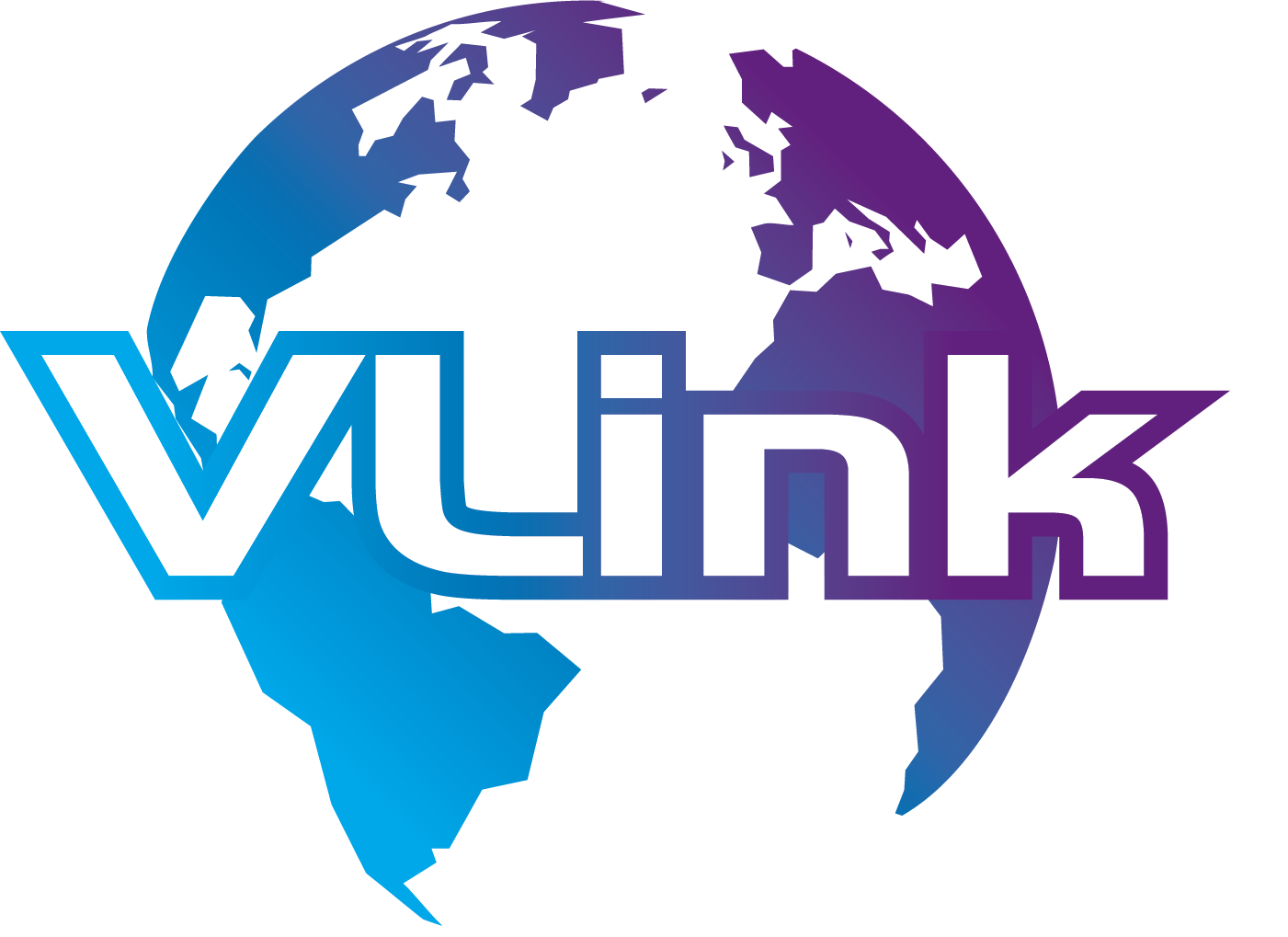









 Shivisha Patel
Shivisha Patel
















